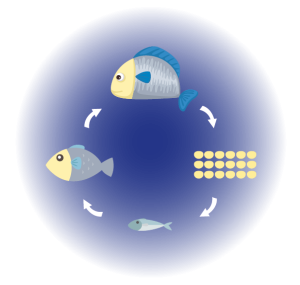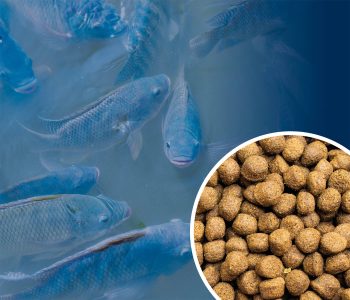Feed accounts for a large portion of the costs in animal production. This is mainly due to volatility and price fluctuations in some of the main ingredients used to manufacture animal diets. Fish nutrition and aquaculture feed are no exception to this. Making diets an important part of high mobile costs in this type of production.

However, the requirements of each animal vary depending on factors such as species, feeding habits and stage of development.
In general, fish obtain and fulfill their nutritional requirements from natural food sources available in the environment such as: plants, smaller animals, phytoplankton and zooplankton; or through commercial diets (feed).
Proper nutrition allows fish to have adequate growth, obtain health benefits and develop a certain level of resistance towards pathogens. Which is especially true and important for animals that are subjected to intensive and super-intensive farming systems.
The development of balanced diets for fish production should be based on overriding factors such as:
Most common feeding habits in fish
Herbivores: These types of fish are capable of ingesting and assimilating fibrous foods, thanks to their rich intestinal microflora. This allows them to ingest and digest between 3 to 4% of their live weight in fiber.
Omnivores: These fish, have diets that are composed by different types of ingredients. Ranging from industrialized feed, to small invertebrates, plants, fruits and decomposing organic matter.
Carnivorous fish: These types of fish, preferably consume foods of animal origin, including invertebrates and other fish. However, they are capable of adapting to the intake of artificial feed from their postlarval stage and beyond.
The latter, tend to have a larger stomach when compared to other fish species with different eating habits.
These definitions of fish’s feeding habits highlight their anatomical and functional compositions. Therefore,we can infer certain aspects of fish feeding habits by carefully looking at the anatomical and histological characteristics of their digestive tract .
Particularities such as the position of the mouth, the type of teeth, the gill apparatus, the cecal pyloric development and the segmentation of the stomach, contribute to determining a fish’s capacity to capture food. As well as influencing the eating habits of each species.
Carbohydrates represent the most controversial nutrient group in fish diets. This is related to the fact that fish do not manifest evident deficiencies or signs of deficiency when subjected to diets without these nutrients.
The levels of dietary carbohydrates can vary, with values ranging from 7 to 20%, depending on the eating habits of each species.
The following factors must be considered in order to carry out a correct feed management in aquaculture:
Development stage
When referring to the stages of development, fish have certain particularities according to the species. In most species, reproduction occurs through egg laying.
After hatching, larvae depend upon a nutrient-rich yolk sac to complete their development. Subsequently, they enter the postlarval phase, where they begin to consume exogenous food sources which vary according to the specific eating patterns and behaviors of each species.
Postlarval phase
When raised with commercial feed, carnivorous species in particular, require an adaptation period during the post-larval stage. They initially receive live food, and are later supplied with diets based on animal protein. These diets are made up of commercial feed that is extruded and then ground, in order to facilitate its consumption and use by the animals.
Feeding frequency
During the development phases, feeding frequency (the number of times that feed is supplied), must be taken into account.
It is worth noting that the early stages demand a higher feeding frequency due to increased nutrient requirements for growth and development.
On the other hand, for animals that are within the reproduction phase, it is necessary to adjust the feeding frequency to the eating habits and behavior of the species.
Feeding rate
The feeding rate comprises the amount of feed that is supplied. It’s calculation is usually based on live weight percentage of the animals. Young animals in the initial phases, require greater amounts of feed in relation to their weight.
In this phase, diets are supplied at 100% of the animal’s live weight.
Final considerations
You may also like to read: “Use of prebiotics, probiotics & synbiotics as additives in aquaculture.”
